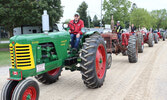2025 Thresher Reunion skirts rain for another memorable weekend in Blyth
BY SCOTT STEPHENSON
While the final numbers are still being tallied, it is fairly safe to say that the Huron Pioneer Threshers and Hobby Association’s (HPTHA) 2025 Reunion Weekend was a huge success. Over the course of the weekend, the Blyth Campground was bustling with the undeniable energy of nine fully-operational steam engines, 226 tractors, four draft horses and an untold number of small engines. The actual camping area itself was populated by 442 campers.
HPTHA President Laura McDonald couldn’t be happier with this year’s edition of the event. “Overall, I’m thrilled with how the show went! Despite the wind and chilly temperatures, we had three days of no rain, which is unheard of for our show,” she pointed out. “And the wind didn’t keep the people away. We had a great turnout of members, attendees, exhibitors, vendors and volunteers. I don’t have the grand total yet, but I do know Saturday’s gate admissions were extremely good… potentially the highest it’s been in the last five years. Everyone I spoke to was having a wonderful time, and they all said they were going to be coming back next year, which means we must have put on a great show for them.”
It’s easy to see why the annual Threshers Reunion at the Blyth Campground is so popular with people of all ages - it’s a hands-on, immersive experience that engages all the senses to transport visitors to a different time period entirely; a time when machines were built to last, and when the agriculture industry ran on teamwork, determination and steam.
Over the course of the weekend, the campground is filled to the brim with the sights, sounds, smells, tastes and textures of the steam era, which gives visitors a rare chance to truly experience history in motion, as it was lived.
Steam engines, those massive machines of the industrial revolution, are a sight to behold. On Friday and Saturday afternoons, the parade of engines around the campground puts that raw power on display, with spectators lining the route to watch the steam era come alive, the intricate workings of their engines on full display. Fire glows through the open mouths of fireboxes, while plumes of steam curl into the air. The whole parade reminds visitors that machines were once built to be repaired, not discarded.
The reunion also features a non-stop wall of sound - every action of an antique machine is accompanied by its own set of sound effects. There’s the roaring rasp of the sawmill’s teeth as it tears through massive logs. As apples slam into the cider press, they surrender their sweet innards with a wet ka-chunk. Boilers whomp and whoosh as coal is stoked. The chug-a-lug of a century’s worth of engine innovation can be heard all across the grounds, while the rhythm of the blacksmith’s hammer keeps irregular time with a staccato ping, distinctly different from the clang-a-lang of the dinner bell. But the most iconic sound of the age is certainly the steam whistle - it’s metallic, ear-splitting, and impossible to ignore. At noon each day, the campground paused as engines across the site announced the hour with a chorus of furious whistles - there is nothing made today that could possibly produce a sound of equivalent volume.
Unlike most museums, Threshers is not a “look but don’t touch” affair - children delight in the hands-on element of the event, especially tasks that would have once been considered chores, like rope-making. Cranking ears of dried corn through the sheller is always a big hit, and this year was no different. By trying out these tactile skills, kids can gain perspective on how much daily labour once went into the conveniences we now take for granted. After the big threshing exhibition, kids were invited to collect some freshly-collected grain to take home. At the blacksmithing station, the ground vibrates with each hammer strike to the anvil. The fire’s intense heat radiates outward, warming exposed skin with a wordless warning to observers not to get too close.
The grounds carry a shifting mix of mingling scents - each engine leaves its own faint signature in the air. There’s the sharp tang of kerosene, the wafting weight of diesel fumes, and the spritely smell of gasoline. Cutting through it all is the sharp smell of fresh sawdust from the mill.
These industrial aromas combine with the welcoming fragrance of the huge pot of white beans and bacon simmered slowly towards lunchtime. In the evening, fresh corn always attracts a line-up of hungry visitors looking for a buttery seasonal treat.
The Threshers Reunion began over 60 years ago, as a chance for veteran threshers to gather and reminisce about their part in the early days of mechanized agriculture. They brought their machines, swapped stories and rekindled friendships. Soon, younger generations joined in, eager to learn historical skills and listen to local stories before they disappeared. Today, the event remains a place where important mechanical knowledge is passed on in a festival setting.
This informal, intergenerational skill-sharing is perhaps the most important legacy of the HPTHA. The engines are spectacular, and the demonstrations compelling, but what lingers is the sense of continuity. In Blyth, for one weekend each September, the steam era roars back to life - not as a distant exhibit, but as a living memory. It is impressively loud, delightfully gritty and deeply human. Every year, the Threshers Reunion keeps the fire of our shared agricultural history stoked, ensuring that the ingenuity and labour of the past remain tangible for just a little while longer.


